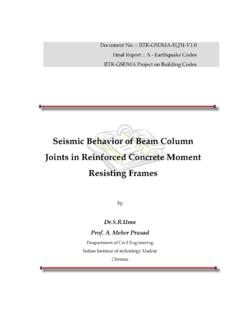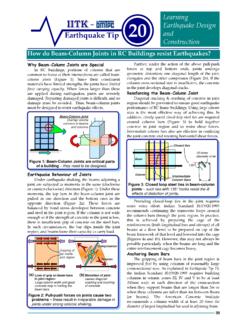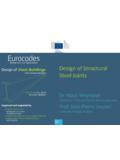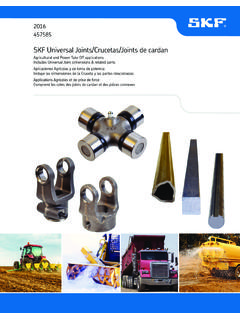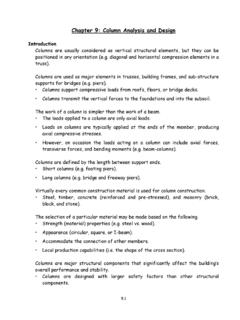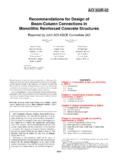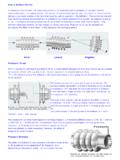Transcription of Finite Element Analysis of Reinforced Concrete Beam-Column ...
1 1200 Abstract Reinforced Concrete (RC) Beam-Column connections especially those without transverse reinforcement in joint region can exhibit brittle behavior when intensive damage is concentrated in the joint region during an earthquake event. Brittle behavior in the joint region can compromise the ductile design philosophy and the expected overall performance of structure when subjected to seismic loading. Con-sidering the importance of joint shear failure influences on strength, ductility and stability of RC moment resisting frames, a Finite Element modeling which focuses on joint shear behavior is present-ed in this article. Nonlinear Finite Element Analysis (FEA) of RC Beam-Column connections is performed in order to investigate the joint shear failure mode in terms of joint shear capacity, defor-mations and cracking pattern. A 3D Finite Element model capable of appropriately modeling the Concrete stress-strain behavior, tensile cracking and compressive damage of Concrete and indirect modeling of steel- Concrete bond is used.
2 In order to define nonlinear behavior of Concrete material, the Concrete damage plasticity is applied to the numerical model as a distributed plasticity over the whole geometry. Finite Element model is then verified against experi-mental results of two non-ductile Beam-Column connections (one exterior and one interior) which are vulnerable to joint shear fail-ure. The comparison between experimental and numerical results indicates that the FE model is able to simulate the performance of the Beam-Column connections and is able to capture the joint shear failure in RC Beam-Column connections. Keywords Finite Element Analysis , Concrete damage plasticity, RC Beam-Column connection, Joint shear failure, Numerical model. Finite Element Analysis of Reinforced Concrete Beam-Column Connections with Governing Joint Shear Failure Mode Najafgholipour a Dehghan b Amin Dooshabi c Arsalan Niroomandi d a Faculty of Civil and Environmental Engineering, Shiraz University of Technology, Shiraz, Iran, b Faculty of Civil and Environmental Engineering, Shiraz University of Technology, Shiraz, Iran, c Graduate student of Civil and Environmental Engineering, Shiraz University of Technology, Shiraz, Iran d Department of Civil and Natural Resources, University of Canterbury, Christchurch, New Zealand Received In revised form Accepted Available online Najafgholipour et al.
3 / Finite Element Analysis of Reinforced Concrete Beam-Column Connections with Governing Joint 1201 Latin American Journal of Solids and Structures 14 (2017) 1200-1225 1 INTRODUCTION Beam-Column connection in Reinforced Concrete (RC) frame is one of the most critical parts of the structure which has important role in seismic performance of these buildings. When a Beam-Column connection of a moment resisting frame is subjected to lateral forces, Beam-Column joint is prone to joint shear failure due to high shear stress which appears in the joint panel as a result of opposite sign moments on both sides of the joint core. This type of failure is not favorable because it has undesirable effects on seismic performance of RC buildings, especially moment resisting frames. The joint shear failure is a brittle type of failure which can adversely affect ductility of the RC frames. Also, early occurrence of this failure causes the beams not to reach their ultimate flexural capacity.
4 Finally, the exposure of severe damage in the joint region may lead to total collapse of the building when the structure is in the seismically active regions and designed according to non-seismic design guidelines before the application of modern seismic design codes (ACI 318-14, ACI 352R-02, ASCE 41-13 and NZS3101). Therefore, this type of failure has undesirable effects on global seismic perfor-mance of RC structures, especially moment resisting frames. Considerable amount of experimental and analytical studies have been carried out to investigate the seismic performance of RC Beam-Column joints subjected to lateral earthquake loading (Elsouri and Harajli (2013), Lee et al. (2009), Masi et al. (2013) and Sasmal et al. (2013)) or development of retrofitting techniques for vulnerable existing RC beam column joints (Eslami and Ronagh (2014), Esmaeeli et al. (2014), Vecchio et al. (2016), Shwan and Abdul Razak (2016), Esmaeeli et al. (2015) and Campione et al (2015)). Some of these researches were concentrated on shear resistance and behavior of RC Beam-Column joints.
5 As one of the first studies in this field Hanson and Connor (1967) suggested a quantitative definition of joint shear. Based on their definition, joint shear was determined from a free-body diagram, at mid-height of the joint panel. Pauley et al (1978) intro-duced qualitative analytical shear resistance mechanisms of RC Beam-Column joints including a Concrete strut and a truss. The first mechanism is a diagonal compression Concrete strut that trans-fers the compression forces from the beam and column actions without the contribution of shear reinforcement. The second mechanism is a stress mechanism that transfers bond forces from the longitudinal bars utilizing horizontal and vertical joint shear reinforcement and Concrete struts, therefore the shear resistance in the joint region corresponding to Concrete truss mechanism is at-tributed to the bond capacity between reinforcement and Concrete . These basic studies were fol-lowed by experimental researches on RC joints aimed at evaluation of their shear behavior (De Risi et al.)
6 (2016), Kotsovou and Mouzakis (2012) and Hakuto et al. (2000)). The tests were done on different joint types such as exterior, interior, knee and T joints in different scales. In these experi-mental studies the effects of different parameters such as geometrical properties of the joint panel, Concrete compressive strength, transverse joint reinforcement, beam longitudinal reinforcement, existence of RC slab, column axial load and etc. were investigated on the joint shear strength and load-displacement curves of the RC joints. Clyde et al (2000) and Pantelides et al (2002) carried out seismic tests on some half-scale exterior Beam-Column joint specimens in order to determine perfor-mance levels according to FEMA273 guidelines. Park and Mosalam (2012) tested four full-scale exterior Beam-Column joints with orthogonal transverse beams and floor slabs under variable col-umn axial loads. They investigated the behavior of unreinforced exterior joints subjected to cyclic loading.
7 Their investigation was focused on the effect of some crucial parameters, such as joint as-1202 Najafgholipour et al. / Finite Element Analysis of Reinforced Concrete Beam-Column Connections with Governing Joint Latin American Journal of Solids and Structures 14 (2017) 1200-1225 pect ratio and beam longitudinal reinforcement ratio on the shear strength and deformability of exterior connection joints comparing their test results with the ASCE 41 seismic design recommen-dations. A series of researchers have collected the test results in literature and have developed empirical and analytical relations to predict the RC joint shear capacity (Pauletta et al. (2015), Muhsen and Umemura (2011), Park and Mosalam (2012), Lima et al. (2012), Wong and Kuang (2014), Wang et al. (2012), Jeon et al. (2014) and Kassem (2016)). For example Kim and Lafave (2007) collected experimental results of semi-static cyclic tests carried out by different researchers on various types of RC Beam-Column connections (exterior, interior and corner joints).
8 All specimens had a minimum amount of joint confinement and the main objective of the study was to investigate the most influ-ential parameters affecting the joint shear load-displacement behavior. The parameters investigated were material property, joint panel geometry, confining reinforcement, reinforcement bond condition and the column axial force. A design approach for RC Beam-Column joint was presented by Kotsovou and Mouzakis (2012). The basic assumption of their model was that the load transferred from the linear elements to the joint is mainly resisted by a diagonal strut mechanism. In a state of the art article, Lima et al (2012) reviewed some of the analytical and empirical models introduced in the last two decades for predicting shear strength of RC Beam-Column joints. Some simplified mod-els are also developed for simulation of the joint shear behavior in nonlinear static and dynamic Analysis of RC frames (Sharma et al. (2011), Favvata et al.)
9 (2008) and Shayanfar et al. (2016)). For instance, model developed by Shayanfar et al (2016) is one of the recent models for this purpose. They have introduced a frame model to simulate the RC joints in nonlinear Analysis of RC frames. A series of numerical studies have been done on RC joints using FEM Analysis . For example Ni-roomandi et al (2014) performed numerical investigation of affecting parameters on the shear failure of non-ductile exterior joints. According to their numerical results, two crucial parameters influenc-ing the joint shear behavior were joint aspect ratio and beam longitudinal reinforcement ratio. Although a majority of numerical studies have been carried out on RC Beam-Column connec-tions (Parvin and Granata (2000), Mostofinejad and Talaeitaba (2006), Niroomandi et al (2010), Mahini and Ronagh (2011), Masi et al. (2013) and Haach et al. (2008)) by FEM softwares such as ANSYS, ABAQUS and DIANA, these studies have concentrated on simulating flexural behavior of beams and columns adjacent to the joint region and are not focused on joint shear behavior of RC connections, while in many cases the shear strength and behavior of joints control the overall re-sponse of RC Beam-Column connections subjected to seismic actions.
10 It should be noted that captur-ing shear dominant failure mode in discontinuity region of connection is a very complicated numeri-cal simulation problem. The suggested modeling technique in this paper has been conducted by means of the commer-cial FEA program ABAQUS and calibrated by modeling and analyzing experimentally tested exte-rior and interior Beam-Column connections in which the governing failure mode during simulated seismic actions on the specimens was the joint shear failure type. The comparison between numeri-cal and experimental results, indicates the ability of the proposed method in simulating the govern-ing joint shear behavior even at post peak phase. Najafgholipour et al. / Finite Element Analysis of Reinforced Concrete Beam-Column Connections with Governing Joint 1203 Latin American Journal of Solids and Structures 14 (2017) 1200-1225 2 Finite Element MODELING Nonlinear Finite Element Analysis of RC Beam-Column connections with joint shear failure as the governing failure mode is performed using ABAQUS/Standard.










